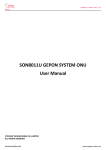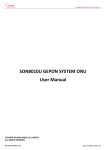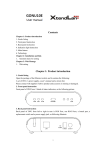Download USER'S GUIDE
Transcript
FAST CENTRIFUGAL PARTITION CHROMATOGRAPHY FCPC USER GUIDE 45 avenue Rhin Danube – 07104 Annonay (France) Phone : +33(0)4 75 69 22 15 – Fax : +33 (0)4 75 67 69 80 E-mail: [email protected] Website: www.kromaton.com 1 USER GUIDE Type: Designation: Seq Rev Page FCPC A200 USE-KRO 01 C 2/14 CONTENTS 1. CENTRIFUGAL PARTITION CHROMATOGRAPHY DEFINITION ___________________3 2. INSTALLATION_______________________________________________________________4 2.1 Unpacking and inspection _____________________________________________________________ 4 2.2 Advice for the installation of the chromatograph __________________________________________ 4 CHARACTERISTICS OF THE CHROMATOGRAPH ________________________________5 3. 3.1 Security ____________________________________________________________________________ 5 3.2 Inappropriate uses ___________________________________________________________________ 5 3.3 Requirement for the user ______________________________________________________________ 5 3.4 Precautions _________________________________________________________________________ 5 USING FCPC® ________________________________________________________________6 4. 4.1 Checking before start up ______________________________________________________________ 6 4.2 How to use the FCPC® (figure 1) _______________________________________________________ 6 4.3 Cleaning ____________________________________________________________________________ 7 CLEANING/MAINTENANCE ___________________________________________________9 5. 5.1 After-sale ___________________________________________________________________________ 9 5.2 Cleaning ____________________________________________________________________________ 9 5.3 Work with very toxic compounds or very strong bases or acids _____________________________ 9 5.4 Check-up ___________________________________________________________________________ 9 5.5 Transport of the chromatograph _______________________________________________________ 9 6. REPLACEMENT OF THE ROTOR ______________________________________________10 7. TROUBLESHOOTING ________________________________________________________12 8. DIAGRAMS__________________________________________________________________13 Before beginning to set up your FCPC, please refer to this user's guide. Keep this document close to the chromatograph. So you can quickly refer to the instructions. Prices and specifications are subject of modifications without notice. Without written authorization by the Kromaton Company, any reproduction of this manual is forbidden. All rights reserved. 2 USER GUIDE Type: Designation: Seq Rev Page FCPC A200 USE-KRO 01 C 3/14 1. CENTRIFUGAL PARTITION CHROMATOGRAPHY DEFINITION Centrifugal Partition Chromatography is an interesting tool for isolation and purification of different kinds of extracts. This method is especially attractive for the fractionation of natural compounds from complex matrices like plant extracts which are rich sources of chemical diversities with a great potential for discovery of new drugs. It is based on the principle of a liquid-liquid partition between two immiscible liquid phases prepared by mixing 2 or more solvents (or solutions). One liquid phase is retained in the FCPC-Kromaton® by centrifugal forces and called “stationary phase”. The second liquid phase is pumped through the stationary phase and is called “mobile phase”. Main characteristics are: 1- No solid support: no irreversible adsorption of the metabolites (no loss of compounds, better decontamination of toxic residues during the purification, gentle treatment of fragile natural compounds) 2- Reduction of solvent consumption: economic impact and better environmental protection 3- Easy and reliable scaleable from analytical to preparative scale: analytical developed methods on a FCPC-Kromaton® with a 200 ml rotor directly up-scaled to a 5-liters preparative rotor Because of the scientific and economic interests for CPC, this method has increased quickly the number of applications in counter current chromatography. 3 USER GUIDE Type: Designation: Seq Rev Page FCPC A200 USE-KRO 01 C 4/14 2. INSTALLATION 2.1 Unpacking and inspection The Fast Centrifugal Partition Chromatography is delivered in a wooden crate. Before unpacking the FCPC, inspect the crate to be sure there is no damage. After carefully unpacking the FCPC, put it on the ground and inspect it to be sure there is no damage on the FCPC. Keep the packing crate: it would be useful if you have to file a claim for damage, or in the case of future transit. If the crate or the FCPC® is damaged: file a claim for any damage immediately with the carrier as he is responsible for damage incurred during the transit. Many carriers must receive a damage claim within three days after delivery, and need to inspect the shipping container. 2.2 Advice for the installation of the chromatograph The FCPC must be handled with the maximum of caution. After unpacking, place it on a plane surface which can support 100 kg at least (laboratory straw mattress for example). The instrument must be far from: - heat source (for example the direct daylight, or a heating system), - corrosive or dusty atmosphere, - vibrations, - possible liquid projections. Let an aeration space (at least 4 inches) at the back of the FCPC in order to maintain the ventilation of inlet/outlet. 4 USER GUIDE Type: Designation: Seq Rev Page FCPC A200 USE-KRO 01 C 5/14 3. CHARACTERISTICS OF THE CHROMATOGRAPH 3.1 Security This equipment is built according to the security standards. However, risks and dangers could exist : if the chromatograph is used in a different way from which it is conceived, if the chromatograph is used by unqualified person. 3.2 Inappropriate uses This equipment is not adapted to injection of solids, particles or other rigid products. The user has to be sure that the material has no precipitation risk when injected in the FCPC. The consequence would be the plugging of the rotor. 3.3 Requirement for the user This chromatograph can only be used by qualified staff or experienced persons. The user's guide could be a support. 3.4 Precautions The system includes fuses against short-circuit. The door security system is “on” when the rotor is on rotation. Thus, it is impossible to open the door of the instrument during his rotation. It is not necessary to lubricate the bearings. It is necessary to wear protective equipment like protective glasses and laboratory clothes when you use the FCPC®. Modifications : Modifications on the FCPC chromatograph are not allowed without written authorization by KROMATON. The user has to inform the manufacturer in case of troubles and incidents that occur during the use of the instrument. There is no guarantee in case of dismantling of the rotor. 5 USER GUIDE Type: Designation: Seq Rev Page FCPC A200 USE-KRO 01 C 6/14 4. USING FCPC® 4.1 Checking before start up Plug in the electrical connection. Connect and verify the inlet and outlet pipings and fittings. Select the elution mode by switching the 4-way valve (picture 1). Turn on the power (on the back of the FCPC®). The LCD lights up. Open the rotor cabinet and check the inlet and outlet pipings and connectors of the rotor. Check and/or bolt the fixing arms on the high-pressure rotary seals. Close the cabinet door. The FCPC® is now ready for use. 4.2 How to use the FCPC® (figure 1) 1. Select biphasic solvent systems (see list of solvent systems). 2. Choose mobile phase after determination of Kd (TLC and HPLC chromatograms are useful). 3. Set the pump flow direction with the mode valve (diagram 2): Upper phase = mobile phase => ascending mode Lower phase = mobile phase => descending mode 4. Mix solvents in a funnel by shaking thoroughly. 5. Connect FCPC® outlet to a 250 ml graduated cylinder. 6. Fill up FCPC® with the stationary phase (20-30 ml/min). 7. Change to mobile phase. 8. Pump mobile phase with the selected flow rate. Increasing the flow rate will increase the backpressure in the FCPC. Be careful not to exceed maximum pressure 60 bars 9. Adjust rotor speed to stay down max. pressure (60 bars) as follow : Rotor (ml) 50 200 1000 Flow rate 1-5 ml/min 2 -15 ml/min 10 -30 ml/min 1800 to 2000 rpm 800 to 2000 rpm 800 to 2000 rpm Rotation speed 10. The stationary phase will be pushed out (10/50% of rotor volume, depending on solvent system). Wait until mobile phase breaks through. Backpressure will increased continuously until hydrodynamic equilibrium is reached (when mobile phase goes out) 11. Inject sample, dissolved in few milliliters of stationary and/or mobile phase. Dissolving sample in both phases can help the dissolution of the sample (for example: 8 ml of S.P and 2 ml of M.P.). The injected volume varies according to the quantity and the solubility of the sample, up to 20% of the column volume. 12. Collect mobile phase in fractions by time function. 13. Runtime in general 30-90 min. 14. Stop the pump and rotor. 6 USER GUIDE Type: Designation: Seq Rev Page FCPC A200 USE-KRO 01 C 7/14 Dual Mode 1. Change phases, e.g. stationary phase becomes mobile phase and change flow rate (ascending/descending). 2. Change mode (switch ascending/descending valve mode) 3. Start pump and FCPC®. 4. Fractionize new mobile phase (stationary phase before). Remarks: 1- Sometimes, there may be a bleeding of the stationary phase. It could be caused by: - the solvent system does not allow a good retention of the stationary phase in these experimental conditions (rotation speed, flow rate …). Parameters should be adjusted to have a good and stable retention (for example increase rotation speed and decrease mobile phase flow rate). Some solvent systems are known to be unstable like Aqueous Two Phase System, chlorinated system... - a "flooding" of the injection volume. If the sample presents a high viscosity, it could push the stationary phase. 2- The sample can be injected: - before the equilibrium of the column ("sandwich" injection): it allows the equilibrium of the column with the sample. - after the equilibrium of the two phases: it can modify the equilibrium. CAUTION: - do not exceed the max.pressure (60 bars), otherwise rotor will leak. - NEVER start the rotation without solvent in rotary seals. 4.3 Cleaning To avoid the eventual contamination of the sample, it is better to clean the column with methanol, if methanol is a good solvent to dissolved impurity. Pump 2 column volumes (Vc) of methanol in ascending mode if the column is empty or in descending mode if the column if full with the stationary phase denser than the methanol. It could be interesting, at the end of the experiment, to recover the stationary phase because some compounds could be strongly retained. 7 USER GUIDE Type: Designation: Seq Rev Page FCPC A200 USE-KRO 01 C 8/14 Figure 1 : How to use FCPC® 8 USER GUIDE Type: Designation: Seq Rev Page FCPC A200 USE-KRO 01 C 9/14 5. CLEANING/MAINTENANCE 5.1 After-sale Modifications and repairs of the FCPC® instrument must be handled by KROMATON. In case of technical problems, please contact the company: KROMATON Sarl 45 avenue Rhin Danube – 07104 Annonay (France) Phone : +33(0)4 75 69 22 15 – Fax : +33 (0)4 75 67 69 80 E-mail : [email protected]. 5.2 Cleaning It may be cleaned with ethanol or acetone. 5.3 Work with very toxic compounds or very strong bases or acids In this case, we advise to rinse out the column after each use with 2 column volumes of methanol and then with water before storing the rotors with water/acetone (1/1). 5.4 Check-up Cleaning: - Monthly: 1. 2. Check the cleanliness of the valve and other parts which are in contact with solvents and samples. Clean the rotor cabinet when necessary with a dry tissue. Maintenance: - Weekly: 1. 2. 3. 4. Check the conditions of the PEEK tubes, connections, fittings, etc. Check the condition of the high-pressure rotary seals. Check the rotor condition. Check if all screws are tight and well positioned - Monthly: 1. Check tightness and condition of the gear-belt. 5.5 Transport of the chromatograph Before moving the instrument, the connections have to be disconnected, the column has to be rinsed out with methanol or emptied with compressed air. Consign the chromatograph in the original packing. 9 USER GUIDE Type: Designation: Seq FCPC A200 USE-KRO 01 Rev Page C 10/14 6. REPLACEMENT OF THE ROTOR 1 2 3 4 1 7 Screws FHc, M5x10 Antirotation bar Nut H, M5 Top guard 3 plastics connections Remove the top guard by unscrewing the 7 fasteners with a male, spherical end, Ø3 hex key. Remove the antirotation bar by unscrewing the nut with a 8/10 spanner, unscrew the white fitting on the rotary seal. Remove the rotary seal connection with the 5/16" spanner, as well as the 2 small connections of the rotor with the key (socket) for plastic connection Ref: P399. Remove the 4 screws H, M8x25 with a tube spanner N°13. 10 USER GUIDE 5 Type: Designation: Seq FCPC A200 USE-KRO 01 6 Rev Page C 11/14 7 2 plugs P-309X Extractions holes Models shown: Rotor 200 ml and rotor 50 ml. Proceed to the replacement of the rotors (several models are available on request). Reassemble the new rotor in the reverse order of dismantling. Replace the 2 plastic connections by 2 plugs Ref: P-309X Insert 2 of the screw M8 into the extraction holes and tighten gradually until the rotor takes off of the hub. Remove the rotor with the hand. Figure 2 : Replacement of the rotor 11 USER GUIDE Type: Designation: Seq FCPC A200 USE-KRO 01 Rev Page C 12/14 7. TROUBLESHOOTING PROBLEM POSSIBLE ORIGIN SOLUTION Leaks Connections Worn-out fittings or ferrule Replace fitting and ferrule and check the tightness. Rotor Check the back-pressure. Solvents leak between Strengthen regularly the bolts. This the circular disks operation should be done after 4 or 5 uses. Rotary seal Solvents leak from the Change the rotary union hole on the side Noises Peek piping Check that the pipings are in place and do not rub an obstacle. Belt Contact us. Bearings Contact us. Cabinet structure unscrewed Screw. Noisy functioning Vibrations Vibration Equilibrium problem of the chromatograph Verify that the 4 feet are placed on a plane surface. 12 USER GUIDE Type: Designation: Seq FCPC A200 USE-KRO 01 Rev Page C 13/14 8. DIAGRAMS ON / OFF Ascending Descending Diagram 2: 4-way ascending/descending valve Choice of the development mode: - Ascending mode: The mobile phase is the upper phase - Descending mode: The mobile phase is the lower phase 13 USER GUIDE Type: Designation: Seq FCPC A200 USE-KRO 01 Rev Page C 14/14 Rotary seal Door lock Peek tube Peek fitting Motor Rotor Bearings Belt Cooling inlet/outlet Pulley Solvent inlet Solvent outlet 4-way valve 14



















